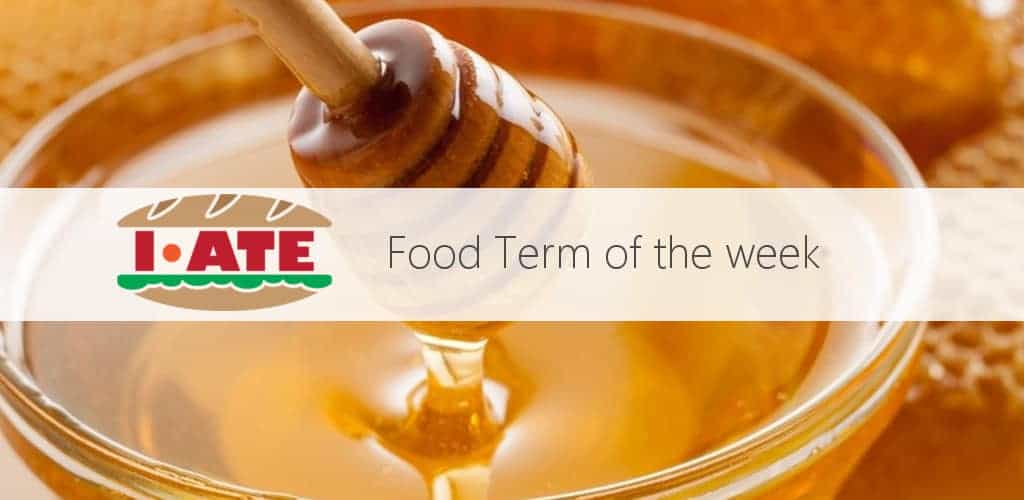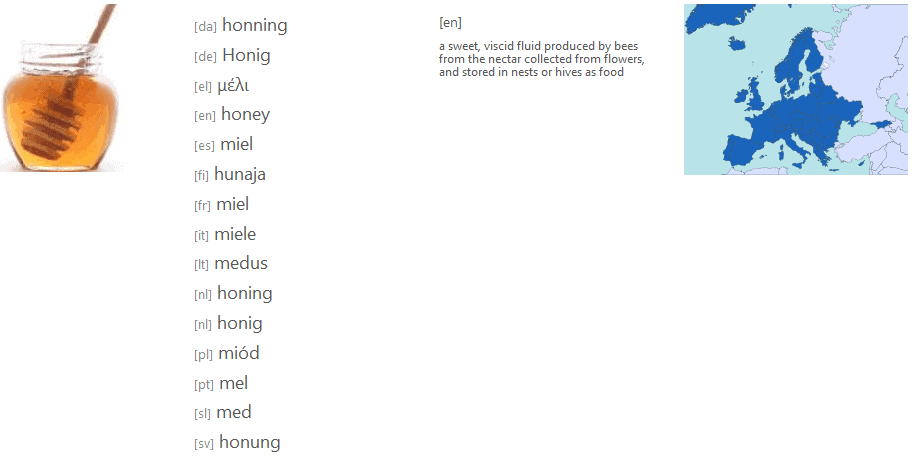
Today´s I-ATE term is honey, a product with the biggest mythological tradition in all the histories in the world. Ambrosia, the food of the Greek gods, was a type of an extremely sweet honey conferring immortality. The “gift of the bees” has also been found in ancient Egyptian tombs, a fact which proves that the food does not get spoiled and it can be preserved till eternity. Called also the “golden elixir”, it is claimed to have many health benefits, as it has been used for thousands of years as a treatment for sore throats and coughs. More specifically, manuka honey, propolis and royal jelly are well-known for their antibacterial properties, healing power and therapeutic uses.
There are different varieties of honey around the globe. The most popular ones in Europe are pine, acacia, chestnut, fir, heather, thyme, eucalyptus, clover and orange blossom honey. However, each country has its own favourite type. For example, consumers in France prefer honey that has been harvested from lavender flowers, and people from Greece prefer honey that has been produced from the wild thyme plant.

Honey is used in numerous recipes, as it is a unique ingredient with a distinctive flavour. It is most frequently used as a spread on bread or in desserts, salad dressing or sauces. However, different countries and cultures use honey differently in their food and cooking. “Pasteli”, “loukoumades” and “diples” are some desserts which cross borders having honey as an integral ingredient. In Greek and Cypriot cuisine pasteli is a sesame seed candy and is generally a flat, oblong bar made with honey and often including nuts. The same dessert exists also in India (“tilor laru”), in Pakistan (“rewri”) and in northern Iran (“peshtezik”). “Loukoumades” (Greek: λουκουμάδες) have alternative names in different countries but they all describe the same pastries made of deep fried dough soaked in honey, with cinnamon and sometimes sprinkled with sesame. In Turkey those “honey balls” are known as “lokma”, in Cyprus as “loukmades”, and in Italy as “struffoli”, where their size is smaller and they are eaten traditionally during Christmas. Chiacchiere or merveilles or chrusciki or δίπλες is another Christmas tradition that we have already discussed in a previous post and they are very often accompanied with honey instead of sugar.

Pasteli |

Loukoumades |
Chiacchiere |
Honey is very often added to drinks to replace sugar, such as mead, milkshakes, beverages, cocktails, tea, water, or even beer. A lot of people in China drink “honey lemon water” (lemon juice and water with honey – served either hot or cold) for its health benefits, while in Scotland and Ireland they drink the so called “hot toddy” (liquor and water with honey, herbs and spices – served hot). “Hot toddy” is very similar to “rakomelo” (Greek: ρακόμελο) which is hot Greek “raki” with honey, or “inomelo” (Greek: οινόμελο) namely hot red wine with honey, cinnamon, oranges and cloves.

Honey lemon water |
Hot toddy |

Rakomelo |

Inomelo |

Go to I·ATE
Written by Anna Manolaki
Study visitor at TermCoord
Student in Multilingual and Multicultural Communication
Sources:
Ambrosia. (2016). Wikipedia. Retrieved 31 August 2016, from https://en.wikipedia.org/wiki/Ambrosia
Bergman, J. (2016). Sweet obsession: China’s manuka madness. Bbc.com. Retrieved 31 August 2016, from http://www.bbc.com/capital/story/20150828-the-golden-elixir-worth-more-than-gold
Geiling, N. (2016). The Science Behind Honey’s Eternal Shelf Life. Smithsonian. Retrieved 31 August 2016, from http://www.smithsonianmag.com/science-nature/the-science-behind-honeys-eternal-shelf-life-1218690/?no-ist
Honey from Greece | Greek Honey | Raw Honey. (2016). Extra Virgin Olive Oil | The Olive Table | Greek Olive Oil. Retrieved 31 August 2016, from https://theolivetable.com/our-honey/
Honey Lemon Tea – China Sichuan Food. (2016). Chinasichuanfood.com. Retrieved 31 August 2016, from http://www.chinasichuanfood.com/honey-lemon-tea/
Honey varieties in Greece. (2016). Honey-center.gr. Retrieved 31 August 2016, from http://www.honey-center.gr/en/index.php?option=com_content&view=article&id=64&Itemid=59&lang=en
Hot toddy. (2016). Wikipedia. Retrieved 31 August 2016, from https://en.wikipedia.org/wiki/Hot_toddy
Italy Honey – Honey Traveler. (2016). Honey Traveler. Retrieved 31 August 2016, from http://www.honeytraveler.com/honey-by-country-region/italy-honey/
Lokma. (2016). Wikipedia. Retrieved 1 September 2016, from https://en.wikipedia.org/wiki/Lokma
Mouthwatering Honey Recipes. (2016). Benefits-of-Honey.com. Retrieved 31 August 2016, from http://www.benefits-of-honey.com/honey-recipes.html
Sesame seed candy. (2016). Wikipedia. Retrieved 1 September 2016, from https://en.wikipedia.org/wiki/Sesame_seed_candy
Some of the Most Popular Honey Varieties. (2016). Hive and Honey Apiary. Retrieved 31 August 2016, from http://www.hiveandhoneyapiary.com/honeyvarieties.html
Struffoli: Italian Christmas Tradition. (2013). The Huffington Post. Retrieved 1 September 2016, from http://www.huffingtonpost.com/franco-lania/struffoli-italian-christmas-tradition_b_4378585.html
Αμβροσία. (2016). El.wikipedia.org. Retrieved 31 August 2016, from https://el.wikipedia.org/wiki/%CE%91%CE%BC%CE%B2%CF%81%CE%BF%CF%83%CE%AF%CE%B1


